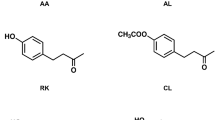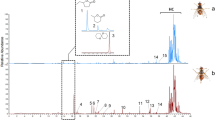Abstract
Bactrocera correcta is an economically important and invasive fruit fly pest. As part of the quest to develop new chemical attractants for potential control of this species, we had previously detected a large amount of β-caryophyllene (CAR) in the pheromone glands of wild B. correcta males. This compound was found in addition to the metabolites from consumed methyl eugenol (ME), a common male lure used for many Bactrocera species. We conducted bioassays to compare the attractiveness of CAR and ME to male B. correcta, determine the behavioural and chemo-ecological basis of the attraction and to monitor their trapping efficacy. Males of B. correcta responded strongly to CAR at a much younger age before sexual maturity compared to ME. CAR feeding increased the male mating success in comparison with lure-deprived males, and CAR-fed males were equally competitive as ME-fed males when competing for conspecific females in semi-field trials. Field trapping data also revealed that ME-baited traps captured both B. dorsalis and B. correcta, while CAR-baited traps brought in only B. correcta males. Numbers of total flies trapped per trap per day (FTD) were also significantly higher in traps baited with CAR compared to ME-baited traps, capturing up to seven times more B. correcta males. This study demonstrated that CAR is a more specific and potent male lure than ME for B. correcta. This discovery may contribute to improve the tools currently available for pest management and border biosecurity against B. correcta.




Similar content being viewed by others
References
Allwood AJ, Chinajariyawong A, Drew RAI, Hamacek EL, Hancock DL, Hengsawad JC, Jirasurat M, Kong Krong C, Kritsaneepaiboon S, Leong CTS, Vijaysegaran S (1999) Host plant records for fruit flies (Diptera: Tephritidae) in South East Asia. Raffles B Zool Suppl 7:92
Anscombe FJ (1948) The transformation of poisson, binomial and negative binomial data. Biometrika 35:246–254
Chyau CC, Chen SY, Wu CM (1992) Differences of volatile and nonvolatile constituents between mature and ripe guava (Psidium guajava Linn.) fruits. J Agri Food Chem 40:846–849
FAO/IAEA/USDA (2003) Manual for product quality control and shipping procedures for sterile mass-reared tephritid fruit flies, version 5.0. IAEA, Vienna, Austria
Fay HAC (2012) A highly effective and selective male lure for Bactrocera jarvisi (Tryon) (Diptera: Tephritidae). Aust J Entomol 51:189–197
Hee AKW, Tan KH (1998) Attraction of female and male Bactrocera papayae to conspecific males fed with methyl eugenol and attraction of females to male sex pheromone components. J Chem Ecol 24:753–764
Hee AKW, Ooi YS, Wee SL, Tan KH (2015) Comparative sensitivity to methyl eugenol of four putative Bactrocera dorsalis complex sibling species—further evidence that they belong to one and the same species B. dorsalis. Zookeys 540:313–321
IAEA (2003) Trapping Guidelines for Area-wide Fruit Fly Programmes. Joint FAO/IAEA Division of Nuclear Techniques in Food and Agriculture, Austria
IPPC (2013) Quarantine Pest list. https://www.ippc.int/static/media/files/publications/en/2013/04/23/1309849796_qp_list.pdf. Accessed 27 Feb 2017
Liu XF, Jin Y, Ye H (2013) Recent spread and climate ecological niche of the invasive guava fruit fly, Bactrocera correcta, in mainland China. J Pest Sci 86:449–458
Metcalf RL (1987) Plant volatiles as insect attractants. Crit Rev Plant Sci 5:251–301
Nishida R, Tan KH, Serit M, Lajis NH, Sukari AM, Takahashi S, Fukami H (1988a) Accumulation of phenylpropanoids in the rectal glands of males of the oriental fruit fly, Dacus dorsalis. Experientia 44:534–536
Nishida R, Tan KH, Fukami H (1988b) Cis-3, 4-dimethoxycinnamyl alcohol from the rectal glands of male oriental fruit fly, Dacus dorsalis. Chem Exp 3:207–210
Ooi YT, Wee SL (2016) Sexual maturation, mating propensity and remating incidence of Zeugodacus tau (Walker) (Diptera: Tephritidae). J Asia Pac Entomol 19:451–457
Orankanok W, Chinvinijkul S, Sawatwangkhoung A, Pinkaew S, Orankanok S (2013) Methyl eugenol and pre-release diet improve mating performance of young Bactrocera dorsalis and Bactrocera correcta males. J Appl Entomol 137:200–209
Poramarcom R, Baimai V (1996) Sexual behavior and signals used for mating of Bactrocera correcta. In: McPheron BA, Steck GJ (eds) Fruit fly pests—a world assessment of their biology and management. St Lucie Press, Florida, pp 51–58
Steiner LF, Mitchell WC, Harris EJ, Kozuma TT, Fujimoto MS (1965) Oriental fruit fly eradication by male annihilation. J Econ Entomol 58:961–964
Steiner LF, Hart WG, Harris EJ, Cunningham RT, Ohinata K, Kamakahi DC (1970) Eradication of the oriental fruit fly from the Mariana Islands by the methods of male annihilation and sterile insect release. J Econ Entomol 63:131–135
Tamura H, Boonbumlung S, Yoshuzawa T, Varanyan W (2000) Volatile components of the essential oils in the pulp of four yellow mangoes (Mangifera indica L.) in Thailand food science and technology research. Food Sci Tech Res 6:68–73
Tan KH (1985) Estimation of native populations of male Dacus spp. by Jolly’s stochastic method using a new designed attractant trap in a village ecosystem. J Plant Prot Tropics 2:87–95
Tan KH, Nishida R (1996) Sex pheromone and mating competiton after methyl eugenol consumption in the Bactrocera dorsalis complex. In: McPheron BA, Steck GA (eds) Fruit fly pests: a world assessment of their biology and management. St. Lucie Press, Delray Beach, FL, pp 147–153
Tan KH, Nishida R (2000) Mutual reproductive benefits between a wild orchid, Bulbophyllum patens, and Bactrocera fruit flies via a floral synomone. J Chem Ecol 26:533–546
Tan KH, Nishida R (2007) Zingerone in the floral synomone of Bulbophyllum baileyi (Orchidaceae) attracts Bactrocera fruit flies during pollination. Biochem Syst Ecol 31:334–341
Tan KH, Nishida R, Jang EB, Shelly TE (2014) Pheromones, male lures, and trapping of tephritid fruit flies. In: Shelly TE, Epsky N, Jang EB, Reyes-Flores J, Vargas RI (eds) Trapping and the detection, control, and regulation of tephritid fruit flies. Springer, New York, pp 15–74
Tokushima I, Orankanok W, Tan KH, Ono H, Nishida R (2010) Accumulation of phenylpropanoid and sesquiterpenoid volatiles in male rectal pheromonal glands of the guava fruit fly, Bactrocera correcta. J Chem Ecol 36:1327–1334
Vargas RI, Leblanc L, Pinero JC, Hoffman KM (2014) Male annihilation, past, present, and future. In: Shelly TE, Epsky N, Jang EB, Reyes-Flores J, Vargas RI (eds) Trapping and the detection, control, and regulation of tephritid fruit flies. Springer, New York, pp 493–511
Wang XJ (1996) The fruit flies (Diptera: Tephritidae) of the East Asian region. Acta Zool Sin 21:52–59
Wee SL, Tan KH (2000) Sexual maturity and intraspecific mating success of the two siblings of the Bactrocera dorsalis Complex. Entomol Exp Appl 94:133–139
Wee SL, Hee AKW, Tan KH (2002) Comparative sensitivity to and consumption of methyl eugenol in three Bactrocera dorsalis (Diptera: Tephritidae) complex sibling species. Chemoecology 12:193–197
White IM, Elson-Harris MM (1992) Fruit flies of economic significance: their identification and bionomics. CAB, Wallingford
Wong TTY, McInnis DO, Nishimoto JI (1989) Relationship of sexual maturation rate to response of oriental fruit fly strains (Diptera: Tephritidae) to methyl eugenol. J Chem Ecol 15:1399–1405
Wong TTY, McInnis DO, Ramadan MM, Nishimoto JI (1991) Age-related response of male melon flies Dacus cucurbitae (Diptera: Tephritidae) to cue-lure. J Chem Ecol 17:2481–2487
Acknowledgements
We thanked Phatchara Kumjing, Weerawan Sukaumnouyporn, Weera Kimjong and Chanon Maneerat for fruit fly rearing and technical assistance. We also thanked Professor David Haymer (University of Hawaii, Honolulu) for proofreading the revised version of the manuscript. The work is supported by Research Contract 20443 (FAO/IAEA) and Research Incentive Grant (GP-K016221) by Ministry of Higher Education, Malaysia awarded to S.L.Wee.
Author information
Authors and Affiliations
Corresponding author
Ethics declarations
Conflict of interest
The authors have declared that no conflict of interest exists.
Informed consent
Informed consent was obtained from all individual participants included in the study.
Ethical approval
This article does not contain any studies with human participants or animals (vertebrates) performed by any of the authors.
Additional information
Communicated by P. G. Becher.
Rights and permissions
About this article
Cite this article
Wee, S.L., Chinvinijkul, S., Tan, K.H. et al. A new and highly effective male lure for the guava fruit fly Bactrocera correcta . J Pest Sci 91, 691–698 (2018). https://doi.org/10.1007/s10340-017-0936-y
Received:
Revised:
Accepted:
Published:
Issue Date:
DOI: https://doi.org/10.1007/s10340-017-0936-y




